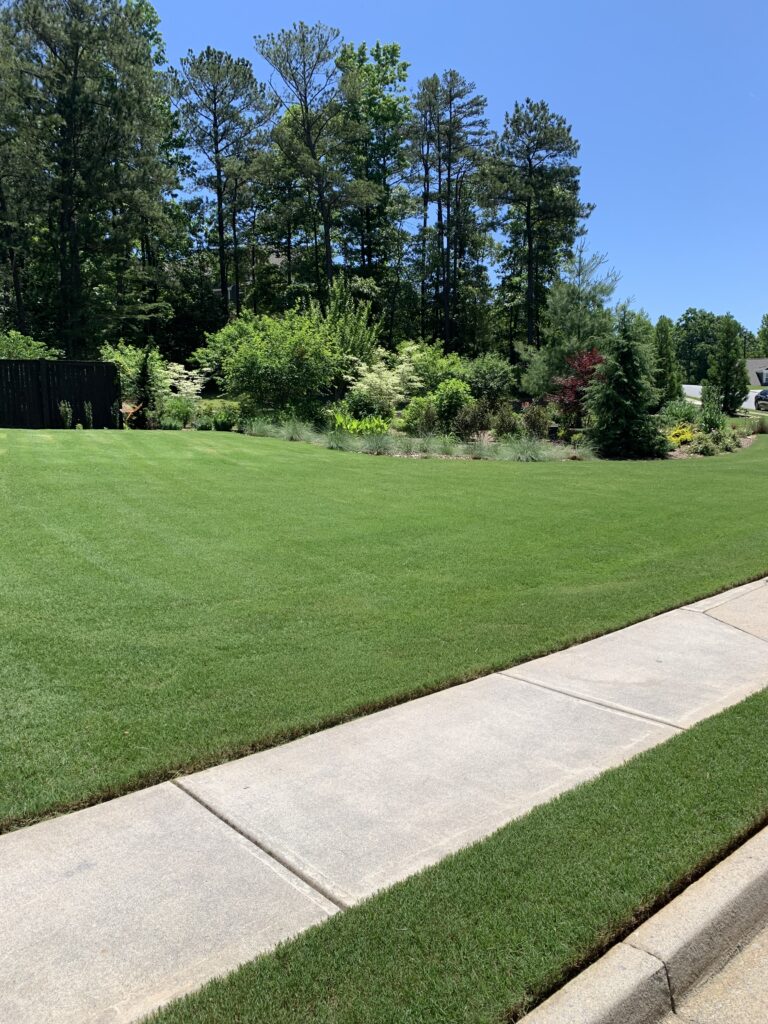Georgia summers bring intense heat and humidity—conditions that weaken turf and encourage weeds like crabgrass, spurge, and nutsedge. Left unchecked, these invaders can choke out your lawn, leaving bare patches and inviting pests.
The solution? A strategic combination of post-emergent weed control and mid-season fertilization. At Pye Landscape Co., we tailor science-driven treatments to keep your turf thriving all summer.
Why Summer Is Prime Time for Weeds in Georgia
Summer in Georgia creates the perfect storm for weed growth. Long, sunny days combined with frequent afternoon rainstorms create warm, moist soil conditions that weeds absolutely love.
One of the most aggressive invaders is crabgrass, a fast-growing annual weed that germinates once soil temperatures hit around 55°F—a threshold typically reached in late spring or early summer in North Georgia. Once established, a single crabgrass plant can produce up to 150,000 seeds, making it incredibly difficult to control without a targeted, professional approach.
But crabgrass is just the beginning. Prostrate spurge, nutsedge, bindweed, and lawn burweed are also common nuisances during the summer months in Georgia. These weeds are opportunistic—they establish quickly in weak or bare patches and spread aggressively through both seeds and underground root systems like rhizomes and tubers.
If not treated early and effectively, summer weeds can do more than make your lawn look patchy—they can compete with your grass for water and nutrients, weaken root systems, and ultimately degrade the health and density of your turf. Once they’ve taken hold, many of these weeds are difficult to remove without damaging your lawn in the process. That’s why a strategic combination of weed control and fertilization is essential to maintain healthy, resilient turf throughout Georgia’s hottest months.
The Science of Post-Emergent Weed Control
Once summer weeds begin to emerge, post-emergent weed control becomes essential to keep your lawn healthy and uniform. Unlike pre-emergent treatments—which prevent weed seeds from sprouting—post-emergent solutions target weeds that are already visible and actively growing. These treatments are designed to be absorbed through the leaves and transported down to the roots, ensuring the entire plant is eliminated, not just what’s above the surface. This method is particularly effective against both broadleaf and grassy weeds that are common during Georgia’s warm season.
Timing is critical for post-emergent applications. For best results, treatments should be applied when weeds are in a growth phase—typically during early to mid-summer, when temperatures range between 70°F and 85°F. At this stage, weeds are actively transporting nutrients throughout the plant, making them more vulnerable to treatment. Waiting too long may allow weeds to establish deeper root systems, making them harder to control without damaging nearby turf.
Spot treatments may be necessary throughout the season as new weeds emerge. By staying vigilant and responding quickly, you can prevent these invaders from going to seed and multiplying. This proactive approach keeps your lawn healthier, more uniform, and less prone to future outbreaks.
Why Summer Fertilization Matters
Fertilizing your lawn during the summer is more than just a maintenance task—it’s a strategic move to help your turf survive and thrive during the most stressful time of year. Mid-season fertilization, especially with nitrogen-rich formulas, encourages deeper root development, which is essential for drought resilience and overall lawn strength. Strong roots help your grass access water from deeper in the soil, keeping it green and healthy even when rainfall is inconsistent.
Summer storms, though often heavy, can leach vital nutrients like nitrogen and potassium from the soil, leaving your lawn depleted. Without replenishment, turfgrass struggles to grow, making it more susceptible to weed invasions and thinning patches. According to lawn care experts, restoring these nutrients is critical to maintaining lush, vigorous growth throughout the season.
A well-fertilized lawn is also more resilient to pests, diseases, and physical wear. It recovers faster from foot traffic, heat stress, and even minor droughts. Timing is key: for warm-season grasses like Bermuda and Zoysia, fertilization should be applied from late spring through mid-summer, when the grass is actively growing. As summer winds down, it’s smart to switch to potassium-rich blends that prep your lawn for the cooler months ahead, boosting winter hardiness and disease resistance.
Bring Your Lawn to Life With Our Weed Control & Fertilization Program
Don’t let summer weeds take over. At Pye Landscape Co., we combine targeted weed control with custom fertilization blends designed for North Georgia’s unique soil and climate. Call us today for a free quote at 770-355-3191!
